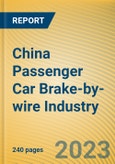Passenger car brake-by-wire research: One-box solution takes an over 50% share.
China Passenger Car Brake-by-wire Industry Report, 2023 combs through and summarizes passenger car brake-by-wire market size, installation of OEMs, and product layout of suppliers.Brake-by-wire can’t develop without vehicle electrification and intelligence. From the perspective of electrification, brake-by-wire uses electronic boosters to solve the problem of lacking vacuum power sources in new energy vehicles, and enables wheel braking energy recovery through motors to improve vehicle cruising range; in terms of intelligence, as the core module for actuation in the 'perception, decision, and actuation' link, brake-by-wire system is the basis for realizing advanced intelligent driving.
At present, emerging car brands like NIO, Li Auto and Xpeng have provided brake-by-wire as a standard configuration (from January to June 2023, the installation rate of brake-by-wire in new energy vehicles was higher than 60%). The installations of brake-by-wire in fuel-powered vehicles increase as well, and TANK 300/500, Tiggo 7/8, Tiggo 7 Plus/8 Plus, Cadillac XT4/5/6, and Cadillac CT4/5/6 among others are all equipped. We predict that in 2025, China's brake-by-wire market will be valued at more than RMB16 billion.
In data’s term, from January to June 2023, the installations of electro-hydraulic brake (EHB) approached 2 million units, a like-on-like jump of 59%; the installation rate exceeded 21%, up 4.92 percentage points compared to the whole year of 2022.
1. One-box has become mainstream among EHB solutions.
In 2022, among EHB solutions One-box boasted a market share 0.66 percentage points higher than Two-box. From January to June 2023, the gap widened to 23.05 percentage points, as the market share of One-box surpassed 50%.2. In 2023, the products of Chinese and foreign suppliers have been iterated to One-Box solutions.
Compared with Two-box, One-Box integrates ESC, features high integration, light weight and low cost, and supports expansion of multifunctional parking and autonomous driving, meeting the redundancy requirements of autonomous driving.Bosch’s mass-produced integrated power brake (IPB) was installed in Cadillac XT4 for the first time in 2019, and was mounted on BYD Han in the following year. Since then, the mass adoption of the brake-by-wire solution One-Box in vehicles has started. During the same period, the foreign mass-produced One-Box products also included Continental MK Cx series and ZF IBC.
Chinese suppliers like Bethel Automotive Safety Systems mass-produced One-Box products in 2021, during which other suppliers in China were deploying Two-Box solutions. Entering 2023, all suppliers' products have been updated and iterated to One-Box solutions.
In China, suppliers that already mass-produce One-Box products include Bethel, FinDreams Powertrain, and LeeKr Technology. Among them, Bethel is backed by Chery; FinDreams Powertrain is backed by BYD; LeeKr Technology is a technology start-up with shares held by FAW, BAIC, and Neta Auto. At present, the IHB-LK® products of LeeKr Technology have supported OEMs such as Chery, Neta Auto, JAC, and Haima.
LeeKr Technology, established in 2021, mass-produced the decoupled hydraulic brake-by-wire system DHB-LK® (Two-box) and the integrated intelligent brake system IHB-LK® (One-Box) in late 2022, making itself the first technology start-up producing One-box in quantities. IHB-LK® has three versions for OEMs: standard, flagship and lightweight. As concerns redundancy solutions, LeeKr has an IHB-LK®+RBU brake-by-wire redundancy solution, meeting the requirements of L3 and above high-level autonomous driving. In 2022, the annual production capacity of IHB-LK® reached 300,000 sets, and it is projected to be expanded to 1.5 million sets during 2023-2024.
3. OEMs like BYD and Great Wall Motor begin to adopt the self-development + joint development model to develop brake-by-wire and reconstruct the supply chain ecosystem.
In the era of conventional automobiles, Tier 1 suppliers played a 'package' role and had a big say in components. Entering the era of intelligent vehicles, OEMs work towards 'independent and controllable' key components, and make more independent development layout in key areas such as autonomous driving, IVI OS, and chassis-by-wire.- BYD self-developed the brake-by-wire system BSC (One Box) through its subsidiary FinDreams Powertrain, and installed it on Dolphin and Qin Pro EV;
- Great Wall Motor independently develops brake-by-wire through its subsidiary Figure Intelligent Technology, and has deployed multiple products like EAD (Two Box), EAI (One Box), and EMB;
- DIAS Automotive Electronic Systems under SAIC has deployed IEB (One-box), and plans to mass-produce it in 2023;
- Chery has achieved mass production and installation of brake-by-wire by binding with Bethel;
This product will be delivered within 3-5 business days.
Table of Contents
1 Overview of Brake-by-wire Industry
2 Passenger Car Brake-by-Wire System Suppliers
3 Brake-by-Wire System Layout of Chinese Passenger Car OEMs
4 Challenges and Development Trends of Brake-by-wire Industry
Companies Mentioned
- Bosch
- Continental
- LeeKr Technology
- ZF
- Hitachi
- Brembo
- Mando
- Bethel
- NASN Automotive Electronics
- TriNova
- Tongyu Automotive
- Global Technology
- Tuopu Group
- JWD Automotive Technology
- FinDreams Powertrain
- Great Wall Motor
- BYD
- SAIC
- Changan Automobile
- Geely
- Chery
- Dongfeng
- FAW Hongqi
- BAIC
Methodology

LOADING...








